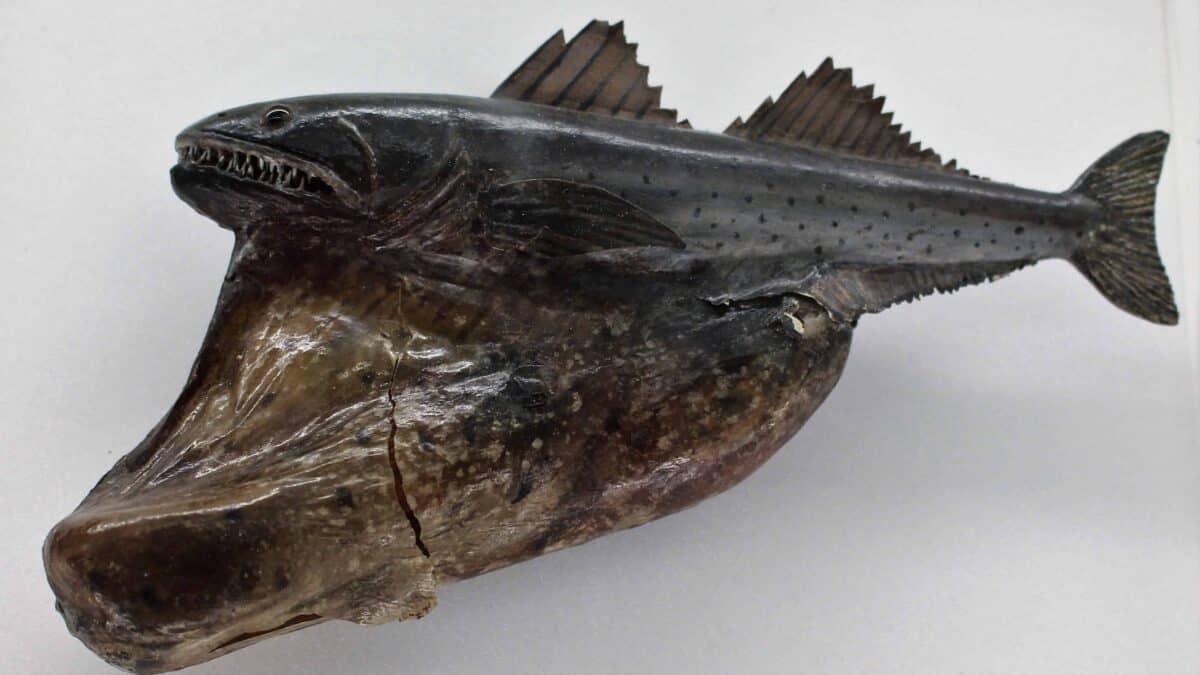The deep ocean is a place of extremes—crushing pressure, perpetual darkness, and freezing temperatures. Yet it’s also home to some of the most alien-looking and ingenious life forms on Earth.
From fish that carry their own flashlights to sea slugs that glide like ghosts, these creatures have adapted to a world that remains largely unexplored by humans.
In this blog, we’ll take a look at 25 bizarre deep-sea dwellers, each one stranger than the last, and discover the clever strategies they use to survive in an environment more hostile than outer space.
If you think you’ve seen it all, prepare to have your imagination stretched in the darkest depths of our oceans.
1. Fangtooth – The Deep-Sea Fish That Forgot to See a Dentist
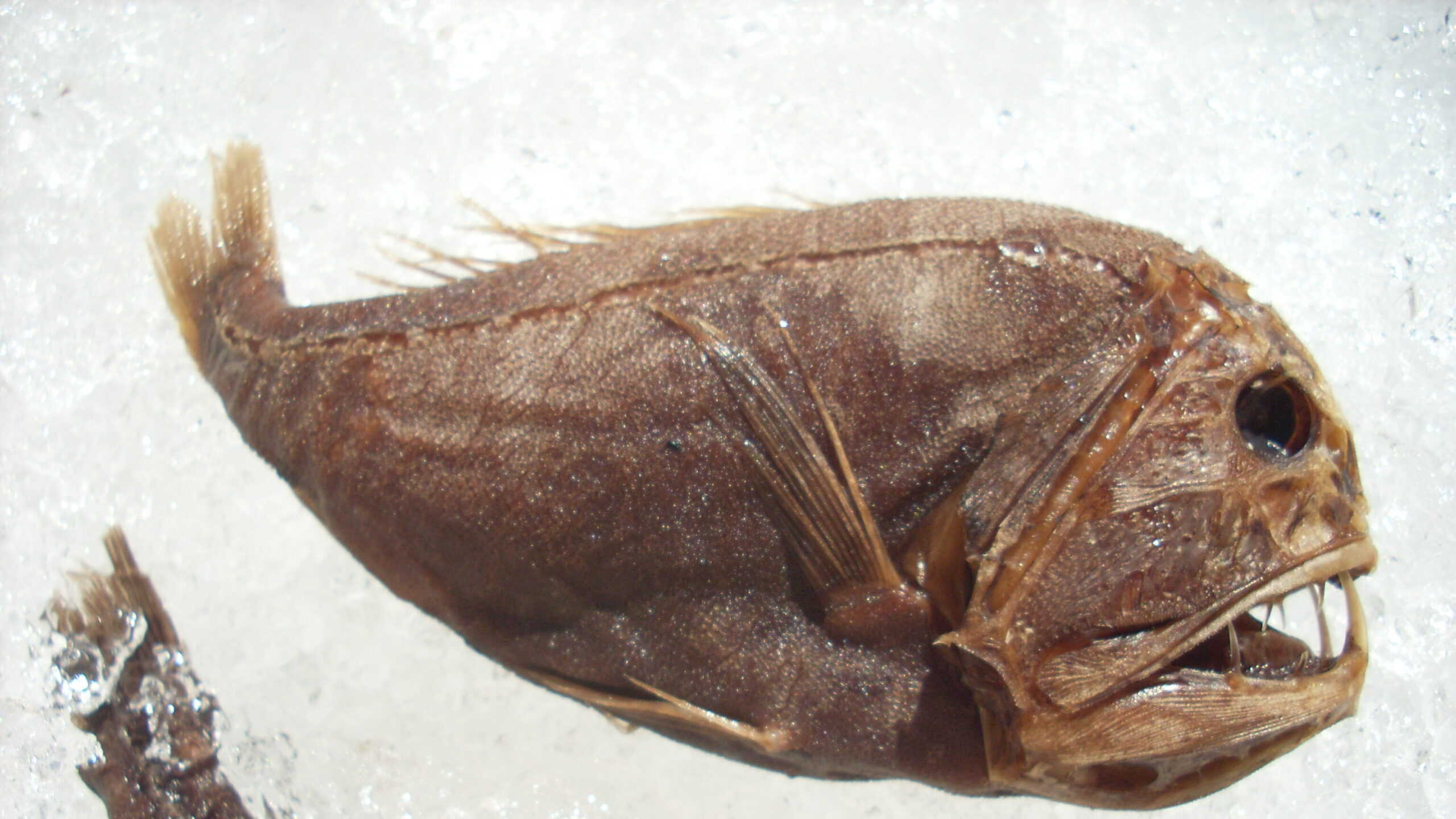
If there were ever a fish that looked like it swam straight out of a horror movie, it’s the fangtooth (Anoplogaster cornuta). But don’t let its oversized fangs and nightmare-inducing grin fool you—this deep-sea dweller is tiny compared to its terrifying appearance, maxing out at just 7 inches (18 cm) long. Think of it as the chihuahua of the deep, except with teeth that belong in a shark movie.
What Makes It So Fearsome?
- Teeth Bigger Than Its Brain: Fangtooths have the largest teeth in proportion to body size of any fish in the ocean. They’re so long that the lower fangs fit into special pockets in the roof of its mouth—because simply closing its mouth isn’t an option.
- Jet-Black Skin & Beady Eyes: Built for life in total darkness, fangtooths have tiny eyes (which aren’t very useful) and rely on their lateral line system to detect vibrations in the water—basically, nature’s version of motion sensors.
Where Does It Lurk?
- Depth Range: Found between 500 and 2,000 meters (1,640–6,560 feet) below the surface, but some individuals have been spotted as deep as 5,000 meters (16,400 feet). That’s deeper than where the Titanic rests!
- Global Reach: You can find them in temperate and tropical oceans around the world—lurking in the dark, where you least expect them.
How Does It Eat With That Jaw?
- Diet: Fangtooths are carnivorous, preying on fish, crustaceans, and squid—sometimes even ones bigger than themselves.
- Hunting Style: Since food is scarce in the deep sea, fangtooths aren’t picky eaters. Thanks to their big mouth and even bigger teeth, they’ll snap up just about anything that wanders too close.
Who Dares to Eat a Fangtooth?
- Despite looking like an oceanic assassin, fangtooths are not at the top of the food chain. Larger fish, including tuna, marlin, and albacore, consider them an easy meal—which just seems unfair for something that already looks like it’s had a rough time.
Fun Fact: They’re Surprisingly Tough
- Many deep-sea creatures can’t survive drastic pressure changes, but fangtooths have been kept alive in captivity for extended periods—a rare feat for deep-sea species.
Why It’s Amazing
The fangtooth is living proof that size doesn’t matter when you have a face like a deep-sea horror villain. Despite its frightening appearance, it’s a harmless, tiny survivor that thrives in one of Earth’s most extreme environments. So while it may look like the stuff of nightmares, the fangtooth is just another perfectly adapted oddball of the deep.
2. Vampire Squid – The Deep Sea’s Cloaked Mystery

With a name like vampire squid (Vampyroteuthis infernalis), you’d expect a bloodthirsty, nightmarish creature lurking in the ocean’s depths. But in reality, this little deep-sea drifter is more of a gothic introvert than a horror villain. Its name translates to “vampire squid from hell”, but instead of sucking blood, it prefers a diet of drifting marine snow (aka dead organic bits floating in the water). Definitely less scary, but still pretty metal.
Why It Looks Like a Tiny Ocean Demon
- Blood-Red or Jet-Black Skin: Depending on the light, vampire squids can shift between deep red and black, making them look like they’re permanently dressed for Halloween.
- Glowing, Deep-Blue Eyes: Their eye color can change depending on the light—sometimes looking bright blue, other times eerie red.
- Webbed Tentacles: Instead of eight independent arms, like an octopus, their tentacles are connected by a cape-like membrane, resembling a vampire’s cloak. When threatened, they flip it inside out, showing off spiky, bioluminescent-covered limbs to freak out predators.
Where Do These Gothic Drifters Lurk?
- Depth Range: Vampire squids are found between 600 and 1,200 meters (2,000–4,000 feet) deep, chilling in the ocean’s oxygen minimum zone—where oxygen is too low for most predators, but just right for them.
- Global Distribution: They drift through temperate and tropical deep waters around the world, content in their perpetual midnight habitat.
What’s On the Vampire Squid Menu?
- Unlike their fearsome name suggests, they don’t hunt living prey. Instead, they feed on marine snow, a fancy name for tiny bits of dead plankton, poop, and organic debris drifting down from above.
- They collect this underwater confetti of decay using sticky filaments, essentially fishing for leftovers in slow motion.
The Art of Avoiding Trouble
- When faced with danger, vampire squids don’t ink like regular squid—they release a bioluminescent mucus cloud, lighting up the water and confusing predators long enough for them to disappear into the darkness.
- If that’s not enough, they can turn themselves inside out, covering their body with their tentacle cloak, making them look like a spiky, unappetizing ball of nope.
Why It’s Amazing
The vampire squid is basically the deep-sea equivalent of a mysterious, misunderstood goth kid—dressed in black, preferring solitude, and drifting through life at its own pace. With its glowing blue eyes, cloak-like webbing, and ability to vanish in the darkness, it’s one of the ocean’s most otherworldly creatures. Not a bloodsucker, but definitely a legend of the deep.
3. Tripod Fish – The Deep-Sea Angler That Stands on Stilts
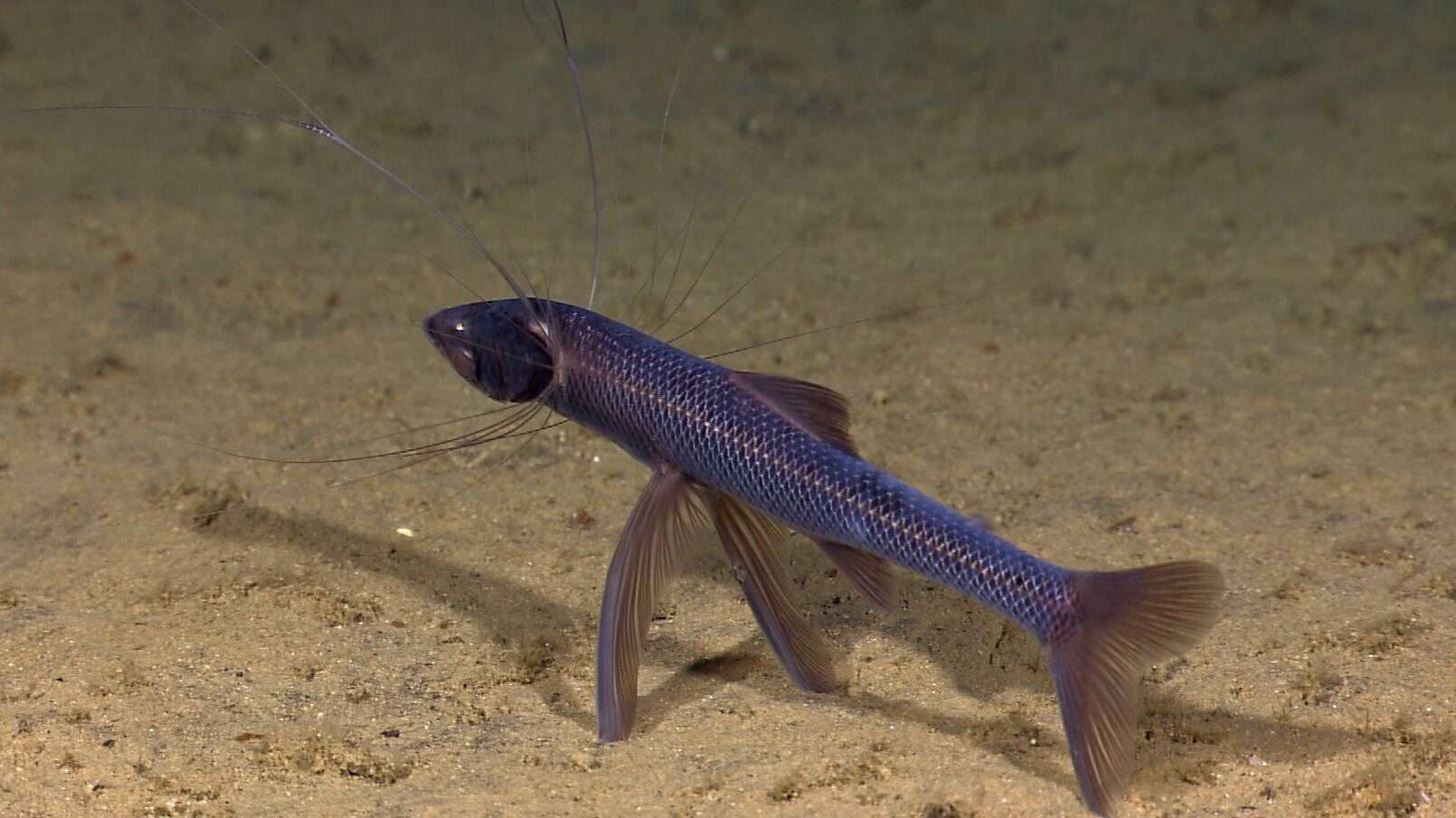
Meet the tripod fish (Bathypterois grallator), the deep sea’s most patient hunter. While most fish swim around looking for a meal, this bizarre creature prefers to plant itself on the ocean floor using its long, bony “stilts”—like a fisherman waiting for the perfect catch. Imagine a fish that decided it was done with swimming and just opted to stand around instead.
Why It Looks Like an Underwater Alien
- Built-in Tripod: This fish has three elongated fin extensions—two from the pelvic fins and one from the tail—that allow it to stand motionless on the seafloor like a deep-sea flamingo.
- Eyeless Wonder: Tripod fish barely use their eyes, since light doesn’t reach the deep-sea depths where they live. Instead, they rely on their long, feathery pectoral fins to sense vibrations in the water, kind of like underwater antennae.
- Pale & Ghostly: Their translucent, silvery body blends seamlessly into the abyss, making them practically invisible to passing predators.
Where Does This Strange Fish Lurk?
- Depth Range: Found between 900 and 4,700 meters (3,000–15,400 feet) deep, they live in an environment where the pressure is intense, the food is scarce, and floating aimlessly is too much work—hence, the stilts.
- Global Wanderer: Tripod fish aren’t picky about location; they’ve been found in deep-sea environments across the world, standing around, minding their business.
How Does It Eat If It Just… Stands There?
- Tripod fish doesn’t chase prey—it lets the ocean bring the food to it.
- It positions itself facing the current, holding out its extra-sensitive fins, waiting for small crustaceans and plankton to drift into its strike zone.
- When the moment is right, it snaps its mouth shut and enjoys its effortless meal. (If only human fishing were this easy.)
Lazy or Genius? You Decide.
- Instead of wasting energy swimming, tripod fish plant themselves like living tripods and let food come to them.
- They’re hermaphrodites, meaning they have both male and female reproductive organs—so if they can’t find a mate in the vast, empty deep sea, they can self-fertilize and keep their species going.
Why It’s Amazing
The tripod fish is proof that sometimes, the best strategy is to just stand still and let life come to you. With built-in stilts, vibration-sensing fins, and the ultimate backup plan for reproduction, this deep-sea oddball is one of nature’s weirdest and most efficient survivors. It may not be the fastest or fiercest predator in the ocean, but it sure has mastered the art of patience.
4. Gulper Eel – The Deep-Sea Balloon Animal
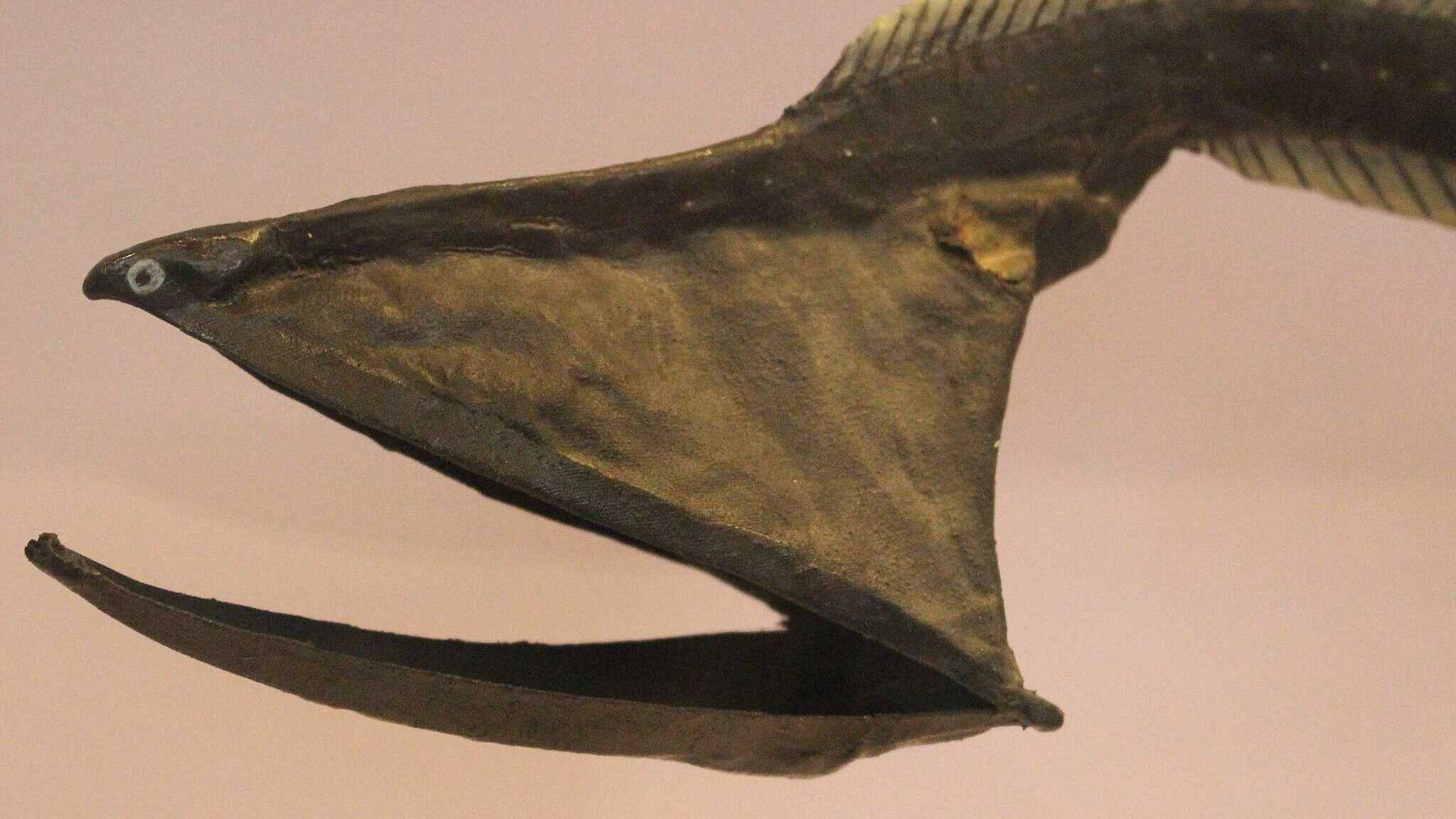
If the deep sea had a mascot for “expect the unexpected,” it would be the gulper eel (Eurypharynx pelecanoides). This bizarre, oversized-mouth wonder looks like someone crossed an eel with a pelican and then stretched it out for fun. It has a massive, expandable mouth, a whip-like tail, and a glowing tip that helps it navigate the pitch-black abyss.
Why It Looks Like a Deep-Sea Prank Gone Right
- Expandable Mouth: The gulper eel’s jaw unhinges to form a giant balloon-like pouch, allowing it to swallow prey much bigger than itself—because when food is rare, you gotta take what you can get.
- Tiny, Almost Useless Teeth: Despite its massive mouth, its teeth are surprisingly small, suggesting that this eel isn’t trying to chew its food—it just gulps it down whole (hence the name).
- Whip-Like Tail with a Bioluminescent Tip: The end of its long, thin tail glows, possibly to lure in unsuspecting prey that think they’re approaching something smaller and snack-sized. Little do they know, they’re the snack.
Where Does This Floating Mouth Lurk?
- Depth Range: Found at depths between 500 and 3,000 meters (1,600–9,800 feet), where light doesn’t exist, and food is hard to come by.
- Global Distribution: They’re found in tropical and temperate deep-sea waters all over the world, proving that weirdness knows no geographical boundaries.
How Does It Eat?
- Unlike traditional eels, the gulper eel isn’t much of a hunter—instead, it relies on its massive mouth to vacuum up whatever it can.
- Its diet includes small crustaceans, squid, and even fish. When prey gets too close, it engulfs them in one massive gulp, stuffing its expandable stomach like a deep-sea hoarder.
- Scientists believe that it sometimes swims with its mouth open like a net, scooping up whatever happens to float inside. (Talk about a lazy but effective meal plan.)
Predators? Not Many—But Some Exist
- With such a soft, squishy body, gulper eels aren’t exactly built for combat. They have very few natural predators, though larger deep-sea creatures like sharks might take a bite if the opportunity arises.
Why It’s Amazing
The gulper eel is proof that when food is scarce, having a gigantic expandable mouth is a winning survival strategy. It doesn’t waste energy chasing prey—it simply waits, gulps, and survives. With its alien-like appearance, bioluminescent tail, and stretchy eating habits, this deep-sea oddity is one of the ocean’s most unexpected and entertaining creatures.
5. Female Anglerfish – The Deep-Sea Queen of Nightmares
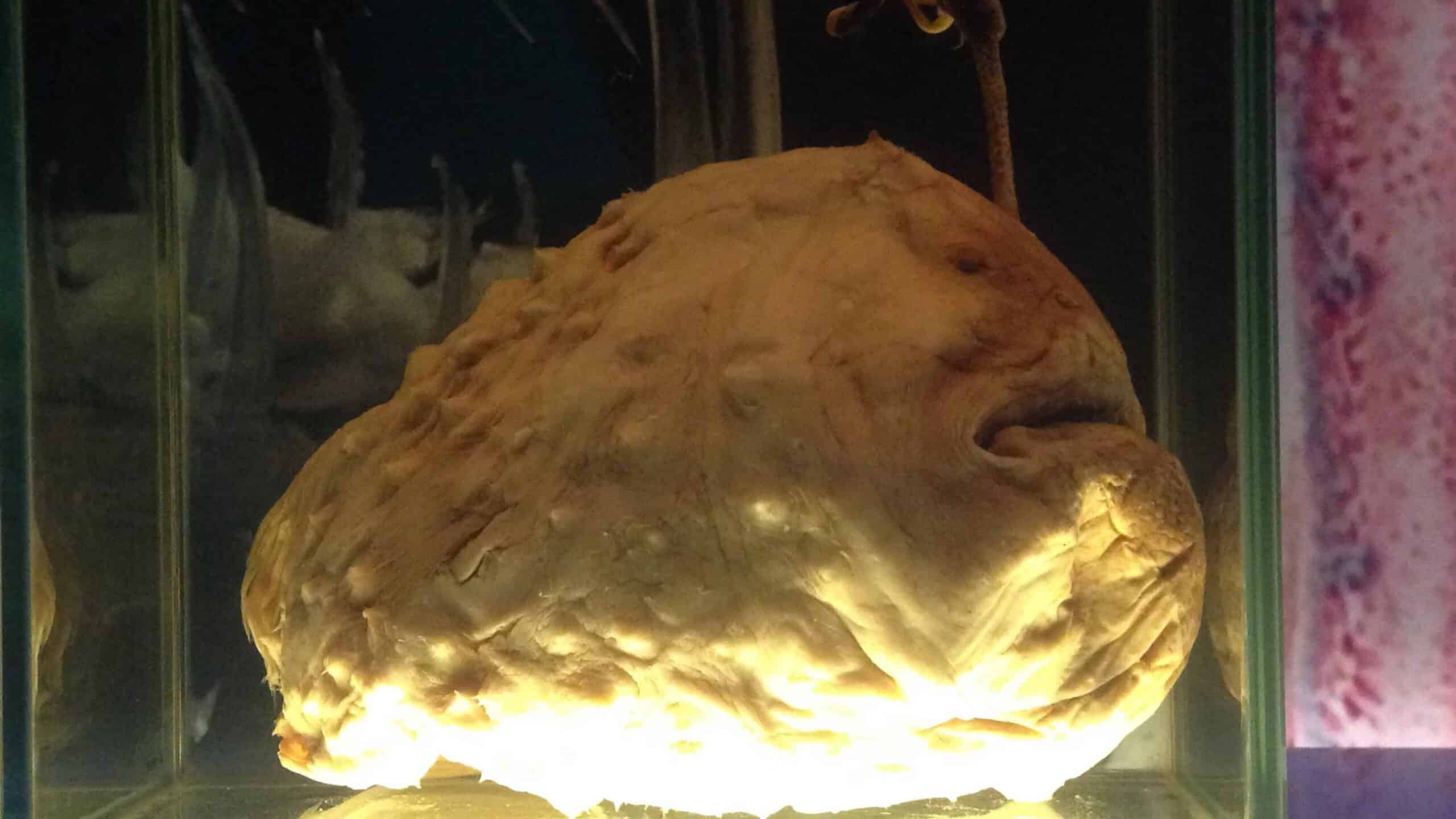
If there were an undisputed horror movie villain of the deep sea, it would be the female anglerfish. With her gaping mouth, dagger-like teeth, and glowing lure, she’s the definition of nightmare fuel—at least if you’re a small fish unlucky enough to cross her path. But beyond the scary looks, the female anglerfish is also one of the most fascinating creatures in the ocean, proving that being weird is sometimes the best way to survive.
What Makes Her So Terrifying?
- Bioluminescent Fishing Rod: That eerie glowing lure dangling from her forehead isn’t just for decoration—it’s a built-in fishing rod filled with bioluminescent bacteria. She waves it around like a creepy deep-sea lantern, tricking prey into thinking they’ve found an easy snack… only to become the snack.
- A Mouth That’s All Business: Her mouth is so large and stretchy that she can swallow prey twice her size—because in the deep sea, you eat whatever you can fit into your stomach.
- Teeth That Lock in Prey: The anglerfish’s teeth curve inward, meaning that once something gets caught in her mouth, it’s never getting out.
Where Does She Lurk?
- Depth Range: The anglerfish thrives in the midnight zone, between 200 to 2,000 meters (660 to 6,600 feet) deep, where sunlight is just a myth.
- Geographical Range: Found in oceans all over the world, proving that nightmare fuel isn’t limited to just one region.
The Weirdest Love Life in the Ocean
If you thought the female anglerfish was strange, wait until you hear about her boyfriend. Actually, “boyfriend” might be too generous of a term—he’s more like a tiny, parasitic tag-along.
- The Male Is 10 Times Smaller: While the female anglerfish grows up to 3.3 feet (1 meter) long, the male is barely the size of a finger. He’s small, weak, and completely useless at surviving on his own.
- He Fuses to the Female… Permanently: When a male finds a female, he bites onto her skin and literally fuses into her body. His organs dissolve, and he becomes nothing more than a permanent sperm donor that she can use whenever she wants to reproduce. Talk about a one-sided relationship.
- She Can Collect Multiple Males: That’s right—some female anglerfish carry several males at once, meaning she’s basically a living, swimming harem of tiny, attached boyfriends.
Why It’s Amazing
The female anglerfish is the ultimate deep-sea survivor—armed with a built-in flashlight, a mouth full of nightmarish teeth, and an entire team of fused-on males ready for reproduction. She doesn’t waste energy chasing food, she lets it come to her. She doesn’t have to search for mates, they attach themselves for life. Terrifying? Yes. Genius? Absolutely.
6. Lovely Hatchetfish – The Deep Sea’s Floating Mirror
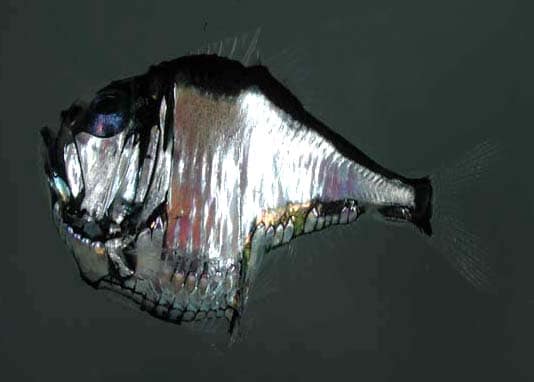
With a name like lovely hatchetfish, you might expect a delicate, charming fish with soft fins and gentle features. Instead, you get a tiny, bug-eyed, razor-thin fish that looks like it’s been flattened by an underwater steamroller. But don’t be fooled—this deep-sea dweller is one of nature’s most brilliantly designed survivors.
What Makes It So Unique?
- A body like a silver coin: The lovely hatchetfish (Argyropelecus aculeatus) has a thin, metallic body that reflects light like a mirror, making it practically invisible to predators lurking below.
- Glowing countermeasures: It comes equipped with bioluminescent organs on its underside—a trick called counterillumination—which allows it to match the faint sunlight filtering down from above, camouflaging it from both upward and downward-looking predators.
- Massive, upturned eyes: Its oversized, upward-facing eyes are perfectly adapted to spotting tiny bits of food drifting down from the ocean above—or to keeping an eye out for things that might want to eat it.
Where Does It Lurk?
- Depth range: Usually found between 200 and 1,500 meters (650 to 4,900 feet), right in the twilight zone of the ocean, where light is barely present.
- Global distribution: Found worldwide in tropical and subtropical waters, proving that looking fabulous is a global phenomenon.
How Does It Eat?
- The lovely hatchetfish isn’t an aggressive hunter—it prefers to hover in place and wait for small crustaceans, plankton, and tiny fish to drift close enough for an easy snack.
- Thanks to its upward-facing eyes, it can spot silhouettes of prey against the faint surface light—a must-have skill when food is hard to come by.
Who’s Trying to Eat It?
- Larger predatory fish like dragonfish and lanternfish consider hatchetfish a quick and easy meal.
- To avoid becoming lunch, it relies on its reflective camouflage and bioluminescent disguise—because the best way to survive in the deep sea is to never be seen in the first place.
Why It’s Amazing
The lovely hatchetfish proves that sometimes, the best defense isn’t fangs or speed—it’s invisibility. With mirror-like skin, glowing countershading, and enormous eyes made for spotting prey, this deep-sea wonder is a tiny but brilliant survivor. It may not be the scariest fish in the ocean, but it’s definitely one of the most cleverly designed.
7. Bloodybelly Comb Jelly – The Deep Sea’s Crimson Enigma
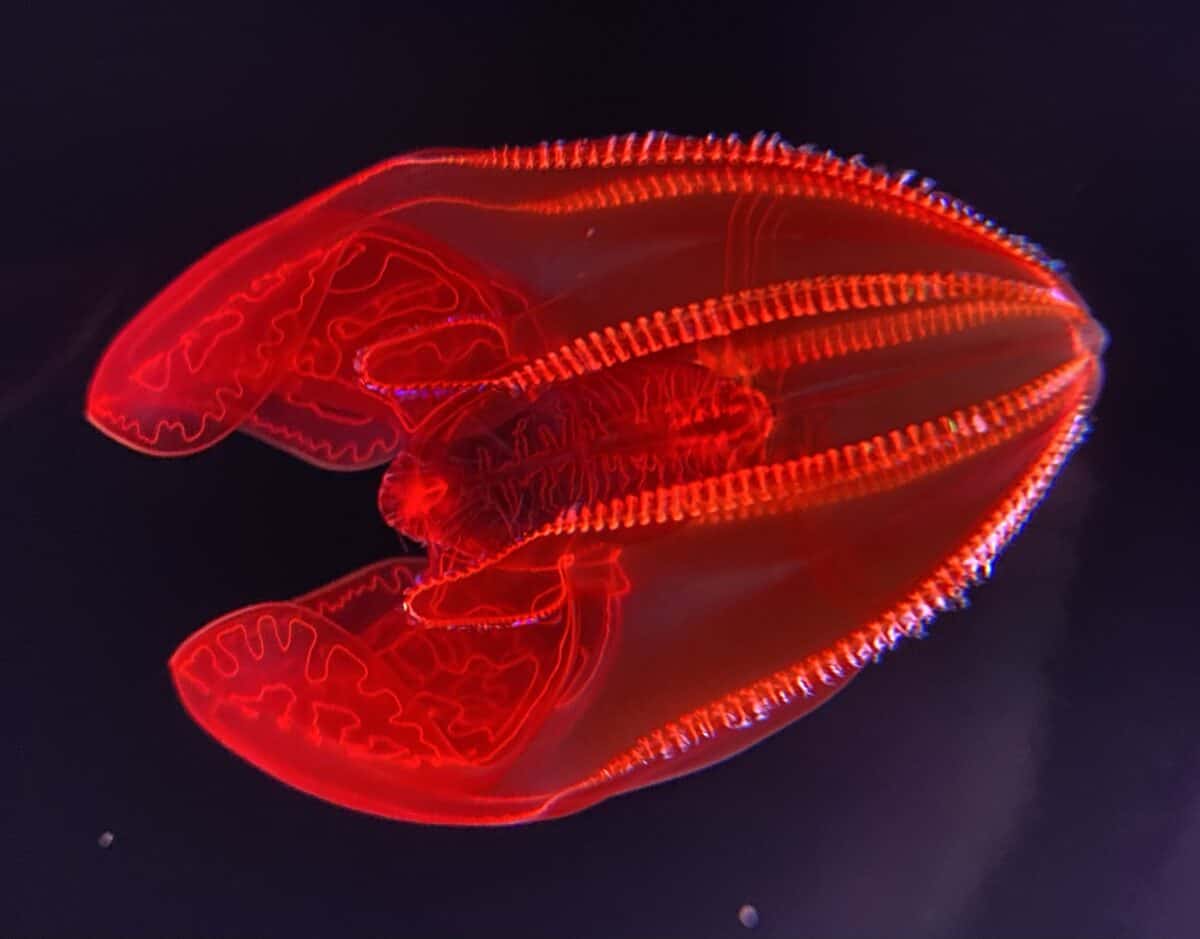
The bloodybelly comb jelly is a mesmerizing ctenophore with a vibrant red coloration that seems to glow like a jewel in the dark waters. Despite its intimidating name, this gelatinous creature is a passive drifter, using rows of hair-like cilia to move gracefully through the ocean.
What Makes It So Unique?
- Brilliant red coloration: Its deep crimson hue actually helps it blend into the blackness of the ocean, because red light does not penetrate far underwater.
- Shimmering comb rows: Like other comb jellies, it uses tiny cilia along its sides to swim, creating flickers of rainbow-like light.
- Transparent body parts: Much of its body can be see-through, revealing flashes of internal structures and any bioluminescent prey it consumes.
Where Does It Lurk?
- Depth range: Often found at depths between 300 and 1,000 meters (1,000 to 3,300 feet), though it can venture deeper.
- Global distribution: Reported in various deep-sea habitats, particularly in the Pacific Ocean, floating through regions where the sun’s rays never reach.
How Does It Feed?
- Passive feeding: The bloodybelly comb jelly lets ocean currents carry microscopic plankton into its sticky oral lobes or tentacles.
- Bioluminescent snacks: Prey that glows can be seen illuminating the comb jelly from inside, giving it a ghostly, iridescent effect.
Who’s Trying to Eat It?
- Larger predators: Deep-sea fish and other ctenophores may target it, though its bright red color conceals it surprisingly well in the black water.
Why It’s Amazing
The bloodybelly comb jelly showcases nature’s artistic extremes, shining like a living ruby in the dark. With its entrancing colors, delicate comb rows, and surprising camouflage strategy, it stands out as one of the deep ocean’s most visually striking wonders.
8. Japanese Spider Crab – The Ocean’s Giant Arthropod

The Japanese spider crab is a crustacean that seems to come straight out of a science fiction movie. Known for its enormous leg span, it holds the record for being one of the largest arthropods in the world. Despite its imposing appearance, it is generally a slow-moving scavenger, often sifting through the ocean floor in search of food.
What Makes It So Unique?
- Remarkably long legs: A fully grown Japanese spider crab can have a leg span reaching up to 3.8 meters (12.5 feet), making it visually striking and somewhat intimidating.
- Long lifespan: It can live for several decades, with some individuals believed to reach over 100 years if they avoid threats and harsh conditions.
- Thick, spiny carapace: Its body shell helps protect against predators and rough terrain, though it often moves slowly due to its size.
Where Does It Lurk?
- Depth range: Commonly found at depths of around 50 to 300 meters (160 to 980 feet), though it has been spotted at greater depths.
- Habitat: Primarily inhabits the Pacific waters around Japan, favoring rocky bottoms and areas with plenty of hiding spots among reefs or underwater structures.
How Does It Feed?
- Opportunistic scavenger: It consumes dead animals, detritus, and occasionally live prey such as small crustaceans and mollusks.
- Food sources: Often combs the seafloor with its long legs, picking up edible material and using its pincers to break apart tougher items.
- Seasonal migrations: There is some evidence that individuals move closer to shallower waters at certain times of the year, possibly for feeding or breeding.
Who’s Trying to Eat It?
- Natural predators: Large octopuses and sharks may prey on juvenile spider crabs, though adult crabs are relatively well protected by their size and hard exoskeleton.
- Human impact: They are sometimes harvested for food, and conservation measures are in place to prevent overfishing.
Why It’s Amazing
The Japanese spider crab is a testament to the ocean’s capacity for producing creatures of staggering proportions. With its sprawling leg span and unexpectedly calm demeanor, this crustacean not only commands attention but also plays a role in maintaining the seafloor ecosystem through its scavenging habits.
9. Pearlfish – The Deep Sea’s Most Unusual Freeloader
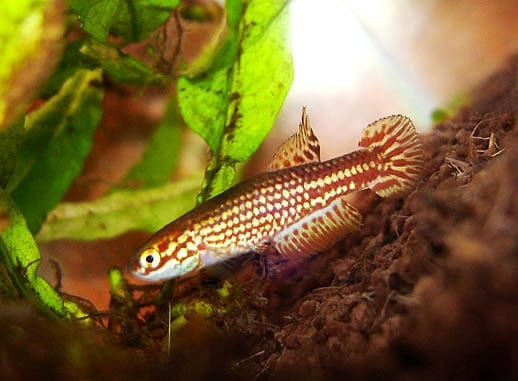
The pearlfish might not look intimidating, but what it lacks in size, it makes up for with one of the strangest survival strategies in the ocean. Instead of hiding in rocks or lurking in the depths, this thin, eel-like fish lives inside the bodies of sea cucumbers. Yes, inside them. If that’s not the most bizarre real estate choice in the deep sea, nothing is.
What Makes It So Unique?
- Unusual shelter: While other fish seek out coral crevices or sandy burrows, the pearlfish prefers the soft insides of sea cucumbers. It swims right into their anuses and lives inside their body cavity.
- Parasite or guest?: Some pearlfish simply use sea cucumbers for shelter, but others eat their host’s internal organs while living inside them—not the best houseguest.
- Transparent body: Many pearlfish species have see-through skin, making them even harder to spot in the already pitch-black ocean.
Where Does It Lurk?
- Depth range: Found between 30 and 2,000 meters (100 to 6,600 feet), meaning they can live in both shallow and deep-sea environments.
- Global distribution: Found in tropical and temperate waters worldwide, proving that bad roommates exist everywhere.
How Does It Eat?
- Pearlfish feed on small crustaceans and plankton, but some species take things further by feeding on the gonads and organs of their sea cucumber hosts—a true definition of taking advantage of free rent.
- Some species are even known to live inside clams and starfish, proving they’re not picky about their homes.
Who’s Trying to Eat It?
- Larger fish and deep-sea predators won’t hesitate to eat a pearlfish if they can find it—though hiding inside another animal does offer some protection.
Why It’s Amazing
The pearlfish takes freeloading to an entirely new level. Instead of dodging predators or finding a normal hiding spot, it crawls inside another living creature and calls it home. Whether it’s a parasite or just an opportunistic tenant, this fish proves that in the deep sea, survival sometimes means making yourself at home where no one else would dare.
10. Ribbon-Sawtail Dragonfish – The Deep-Sea Predator With a Built-In Chainsaw
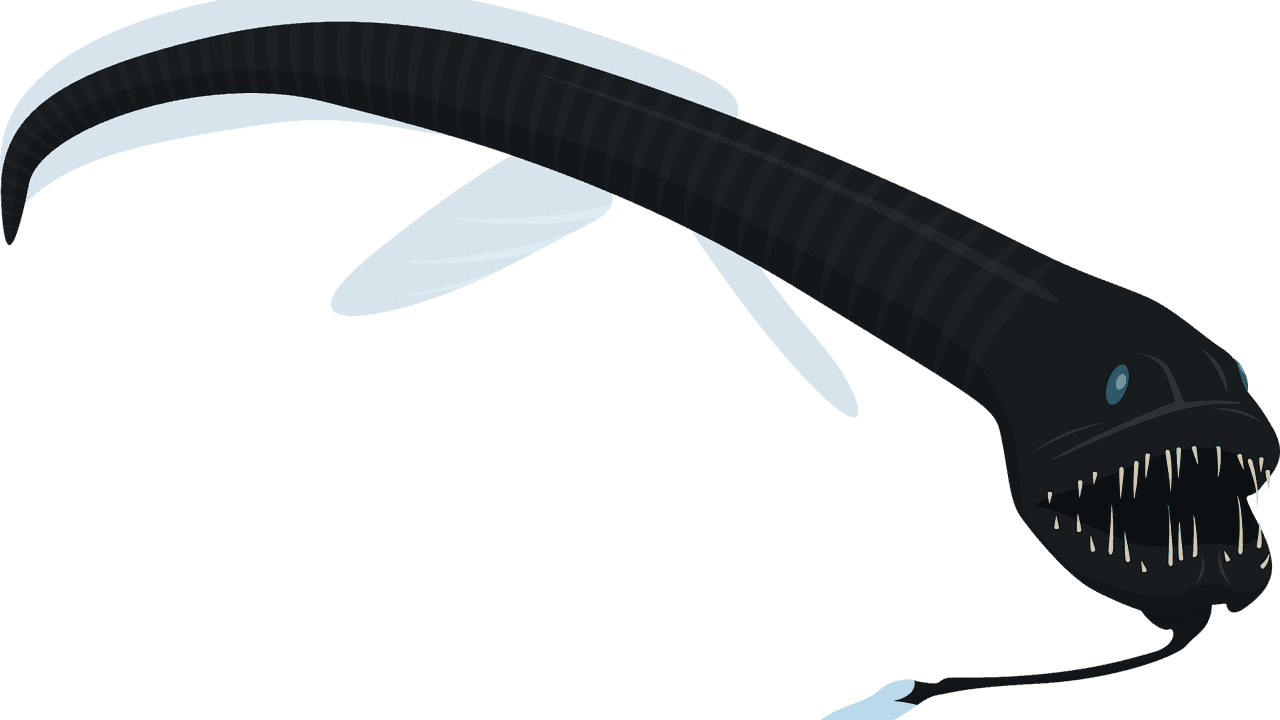
If the dragonfish wasn’t terrifying enough, meet its even more dramatic cousin—the ribbon-sawtail dragonfish. With its razor-sharp teeth, bioluminescent lure, and serrated tail, this deep-sea predator takes stealth hunting to a whole new level.
What Makes It So Unique?
- Built-in saw: The ribbon-sawtail dragonfish gets its name from the serrated, saw-like ridges on its tail, which may help it evade predators or maneuver in the deep sea.
- Glowing lure: Like other dragonfish, it has a bioluminescent barbel hanging from its chin, which it uses to attract unsuspecting prey.
- Sharp, needle-like teeth: Its long, fang-like teeth are so transparent that they are nearly invisible—perfect for sneak attacks.
Where Does It Lurk?
- Depth range: Found between 500 and 2,000 meters (1,600 to 6,600 feet), where no sunlight reaches.
- Global distribution: Found across tropical and temperate deep-sea waters, waiting in the darkness for its next ambush.
How Does It Hunt?
- The dragonfish’s bioluminescent lure flashes to attract smaller fish and crustaceans, drawing them in like a deep-sea flashlight.
- Once the prey gets close, the dragonfish lunges forward with its massive jaws, clamping down with its nearly invisible teeth.
- Its flexible stomach allows it to swallow prey larger than its own head, ensuring no meal goes to waste.
Who’s Trying to Eat It?
- Despite its fearsome look, the dragonfish isn’t at the top of the food chain. Larger deep-sea predators like squid and bigger fish won’t hesitate to take a bite.
Why It’s Amazing
The ribbon-sawtail dragonfish is an expert at deep-sea deception. It glows just enough to trick prey, strikes with near-invisible teeth, and carries a built-in saw on its tail. This stealthy predator proves that in the deep ocean, the best hunters are the ones you never see coming—until it’s too late.
11. Squirrelfish – The Deep-Sea Night Owl
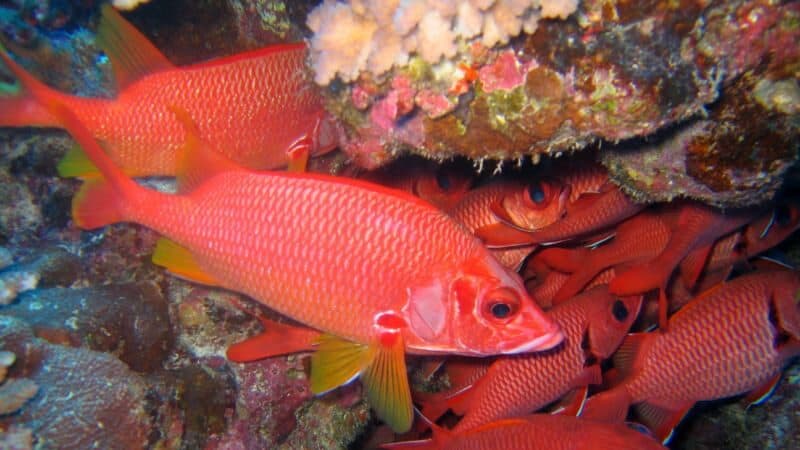
Squirrelfish may sound cute, but these deep-sea dwellers are nocturnal hunters with big, staring eyes and spiky fins. Found lurking in dark caves and rocky crevices, they spend the day hiding and come out at night to hunt. With their glowing red bodies and excellent night vision, they have mastered the art of moving unseen in the shadows.
What Makes It So Unique?
- Oversized eyes: Squirrelfish have large, reflective eyes that help them see in near-total darkness. They are built for night vision, making them expert nighttime hunters.
- Vibrant red color: Their bright red bodies may seem flashy, but in the deep ocean, red light doesn’t travel far, meaning they appear nearly invisible in their environment.
- Spiny dorsal fin: They have sharp, venomous spines along their back, which act as a defense against predators.
Where Does It Lurk?
- Depth range: Found at depths between 10 and 600 meters (30 to 2,000 feet), with some species going even deeper.
- Global distribution: Found in tropical and subtropical oceans worldwide, usually hiding in coral reefs, caves, and rocky formations.
How Does It Hunt?
- Squirrelfish are nocturnal hunters, waiting until darkness falls before searching for small crustaceans, plankton, and tiny fish.
- Their large eyes allow them to detect movement in low-light conditions, giving them an advantage over prey that is less adapted to the dark.
- They communicate using clicking and grunting sounds, which help them warn others of danger or coordinate movements.
Who’s Trying to Eat It?
- Larger predatory fish like groupers and moray eels frequently target squirrelfish.
- Their sharp spines make them a painful meal, discouraging some predators from trying.
Why It’s Amazing
Squirrelfish are perfectly designed for nocturnal survival. With their large eyes, silent movements, and ability to blend into the deep sea’s red-hued world, they are stealthy predators that prove the night belongs to those who can see in the dark.
12. Snaggletooth Dragonfish – The Deep Sea’s Vampire Hunter

If the deep ocean had its own version of a classic monster, the snaggletooth dragonfish would be it. With its long, sharp teeth and a glowing lure that dangles beneath its chin, this terrifying predator is built for ambush. It even has a secret weapon—special pigments that allow it to produce red bioluminescence, making it one of the few creatures in the deep that can see what others can’t.
What Makes It So Unique?
- Glowing red bioluminescence: Unlike most deep-sea creatures that glow blue, the snaggletooth dragonfish produces red light, allowing it to see prey that can’t see it.
- Needle-like fangs: Its long, fang-like teeth stick out even when its mouth is closed, giving it a permanently menacing grin.
- Slim, elongated body: It has a long, flexible body that allows it to move swiftly through the water, sneaking up on unsuspecting prey.
Where Does It Lurk?
- Depth range: Found between 200 and 2,000 meters (650 to 6,600 feet), in the darkest parts of the ocean.
- Global distribution: Found in deep waters across the world’s oceans, making it a true master of the abyss.
How Does It Hunt?
- It uses its glowing lure to attract smaller fish and crustaceans, waving it like a fishing rod.
- When prey gets close, the dragonfish lunges, trapping it between its needle-sharp fangs.
- Its invisible red light helps it hunt without being detected, making it one of the most efficient predators in the deep.
Who’s Trying to Eat It?
- Larger deep-sea predators like squid and even other dragonfish will go after a snaggletooth dragonfish if given the chance.
- Its slim body and sharp teeth help it avoid getting caught, but in the deep sea, everything is fair game.
Why It’s Amazing
The snaggletooth dragonfish is like a vampire of the deep, using its glowing red vision to see what other creatures can’t. With its stealthy movements, needle-like teeth, and advanced hunting abilities, it is one of the most finely tuned predators lurking in the ocean’s darkest depths.
13. Longfinned Bullseye – The Deep Sea’s Watchful Guardian
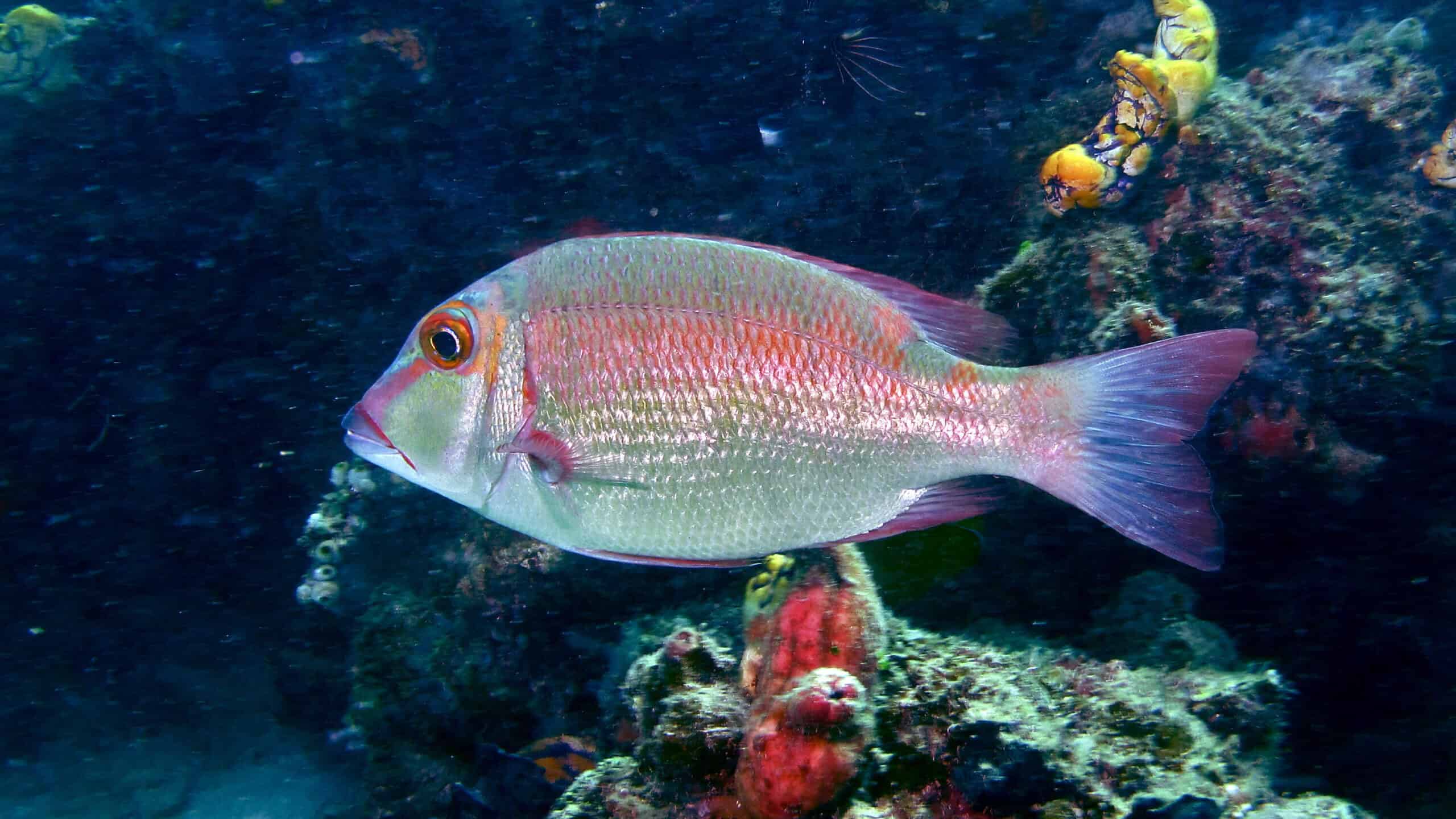
The longfinned bullseye may not be as terrifying as some of its deep-sea neighbors, but what it lacks in fear factor, it makes up for in resilience. With its large, glowing eyes and slow-moving nature, this deep-sea fish is built to thrive in low-light environments, where patience is just as important as speed.
What Makes It So Unique?
- Giant, reflective eyes: The longfinned bullseye has large, mirror-like eyes that help it detect even the faintest glimmers of light in the deep sea.
- Slow but steady: Unlike other deep-sea predators that strike quickly, this fish moves methodically, using patience to wait for the right moment to strike.
- Long, flowing fins: It has elongated fins that give it an elegant, drifting appearance as it moves through the water.
Where Does It Lurk?
- Depth range: Found between 100 and 500 meters (330 to 1,600 feet), making it a resident of the ocean’s twilight zone.
- Global distribution: Found in tropical and subtropical waters, particularly in deep reefs and caves where light is scarce.
How Does It Hunt?
- Instead of chasing down prey, the longfinned bullseye prefers to wait for plankton and small fish to drift within range.
- It uses its large eyes to detect movement in near-total darkness, reacting quickly when food comes close.
- Despite its slow movement, it is a capable ambush predator, striking with precision when the time is right.
Who’s Trying to Eat It?
- Larger fish and deep-sea predators see the longfinned bullseye as an easy target due to its slower speed.
- Its reflective eyes and ability to blend into dark environments help it avoid detection.
Why It’s Amazing
The longfinned bullseye proves that not all deep-sea creatures rely on speed and aggression. With its massive eyes, steady movements, and patient hunting style, it is a deep-sea sentinel, perfectly adapted to surviving in an environment where every flicker of light matters.
14. Joubin’s Squid – The Deep Sea’s Flashy Acrobat
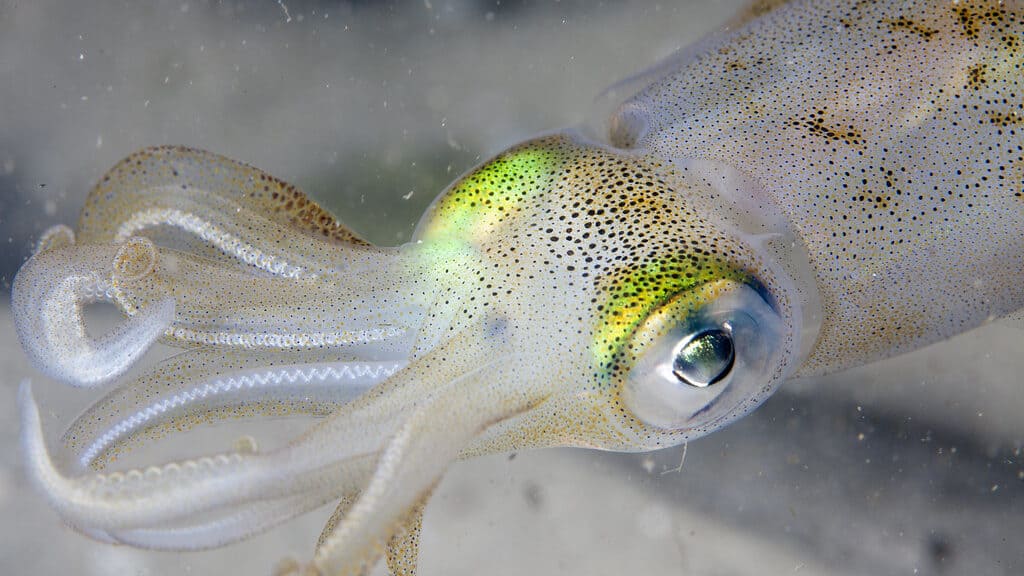
Joubin’s squid may not be the largest or most fearsome squid in the ocean, but what it lacks in size, it makes up for in its dazzling bioluminescence and quick evasive maneuvers. Found in the midwater depths of the ocean, this squid is a master of escape, using bursts of glowing light and sudden, unpredictable movements to avoid predators.
What Makes It So Unique?
- Bioluminescent escape trick: Joubin’s squid can produce flashes of light from its body to confuse predators before making a quick getaway.
- Agile and fast: Unlike sluggish deep-sea creatures, this squid is a fast and nimble swimmer, capable of making rapid direction changes to avoid being caught.
- Soft, gelatinous body: Its flexible body allows it to squeeze into tight spaces, making it harder for predators to catch.
Where Does It Lurk?
- Depth range: Typically found between 200 and 1,000 meters (650 to 3,300 feet) in the ocean’s twilight zone.
- Global distribution: Found in deep waters around the world, particularly in temperate and tropical regions.
How Does It Hunt?
- Joubin’s squid is an opportunistic feeder, preying on small fish, plankton, and crustaceans.
- It uses its quick reflexes and long tentacles to snatch prey before they have a chance to escape.
- Its bioluminescence is sometimes used not just for defense, but also to attract prey in the dark waters.
Who’s Trying to Eat It?
- Deep-sea predators like larger fish and deep-diving marine mammals often hunt Joubin’s squid.
- Its ability to flash and dart away makes it difficult to catch, helping it survive in a dangerous world.
Why It’s Amazing
Joubin’s squid is a deep-sea acrobat, combining speed, flexibility, and dazzling light displays to navigate its dark environment. Whether it’s dodging predators or sneaking up on prey, this squid proves that in the deep ocean, agility and deception are just as important as brute strength.
15. Black Warrior – The Shadow Hunter of the Deep

With a name like Black Warrior, you know this deep-sea fish means business. Lurking in some of the darkest parts of the ocean, it relies on stealth, bioluminescence, and lightning-fast reflexes to ambush unsuspecting prey. Almost nothing is known about this elusive creature, making it one of the ocean’s most mysterious predators.
What Makes It So Unique?
- Deep black coloration: The Black Warrior’s body is covered in ultra-dark pigment, absorbing almost all light and making it nearly invisible in the deep sea.
- Sharp, needle-like teeth: Its long fangs are perfect for trapping prey, ensuring that once something is caught, it isn’t getting away.
- Secretive nature: Very little is known about this deep-sea fish, and scientists are still trying to uncover the details of its lifestyle.
Where Does It Lurk?
- Depth range: Found at extreme depths, likely between 1,000 and 3,000 meters (3,300 to 9,800 feet).
- Global distribution: Its exact range is unknown, but it is believed to inhabit deep-sea trenches and abyssal zones.
How Does It Hunt?
- The Black Warrior is likely an ambush predator, waiting for prey to pass by before striking with incredible speed.
- Its dark coloration allows it to blend seamlessly into its surroundings, making it undetectable until the last second.
- It may use bioluminescent flashes to disorient prey, though this remains speculative.
Who’s Trying to Eat It?
- Due to its deep-sea habitat, the Black Warrior likely has few natural predators, though larger deep-sea fish and squid may target it.
Why It’s Amazing
The Black Warrior is a deep-sea enigma, a predator that lurks in complete darkness, striking without warning. With so little known about it, this shadowy hunter remains one of the ocean’s greatest mysteries.
16. Longwing Spinyfin – The Deep Sea’s Elegant Ghost

The longwing spinyfin may sound delicate, but this deep-sea fish is a survivor, perfectly adapted to an environment where food is scarce and danger is everywhere. With its long, flowing fins and dark, spiky body, it drifts through the water like a ghost, silently hunting for its next meal.
What Makes It So Unique?
- Long, wing-like fins: Its extended fins help it move gracefully through the water, giving it a unique appearance unlike most deep-sea fish.
- Bioluminescent glow: Like many creatures in the deep sea, it uses light-producing organs to communicate and possibly lure in prey.
- Armored body: Covered in spiny scales, the longwing spinyfin has built-in protection against predators.
Where Does It Lurk?
- Depth range: Found between 500 and 1,500 meters (1,600 to 4,900 feet).
- Global distribution: Found in deep waters across tropical and subtropical oceans.
How Does It Hunt?
- The longwing spinyfin is an opportunistic predator, feeding on small fish, squid, and plankton.
- Its bioluminescence may be used to lure prey closer before striking.
- Its wing-like fins allow it to make quick, sudden movements, surprising its prey.
Who’s Trying to Eat It?
- Larger deep-sea predators may target it, but its armored body and quick reflexes make it a challenging meal.
Why It’s Amazing
The longwing spinyfin moves like a deep-sea specter, using its flowing fins and glowing body to navigate the abyss. With its unique adaptations and otherworldly beauty, it’s one of the most elegant hunters of the deep.
17. Giant Cusk Eel – The Deep Sea’s Surprising Giant
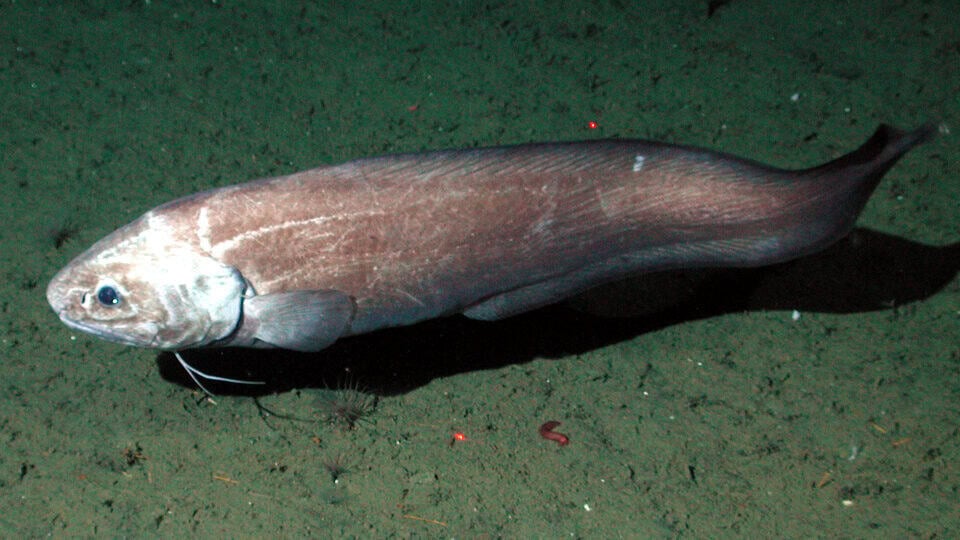
The giant cusk eel, despite its name, is neither a true eel nor does it always reach giant proportions. However, some species are known to grow impressively long and dwell in depths where few fish dare to swim. With a sleek body adapted for life near the seafloor, the giant cusk eel is a master at navigating the high-pressure environment of the deep ocean.
What Makes It So Unique?
- Eel-like appearance: Though called a cusk eel, it is actually part of a separate family of fish, sporting a long, compressed body and a continuous fin running along much of its length.
- Deep-sea resilience: Some species thrive at depths of thousands of meters, enduring crushing pressures and near-freezing temperatures.
- Flexible diet: The giant cusk eel can feed on a variety of prey, from small crustaceans and worms to larger invertebrates, depending on what is available in its often sparse habitat.
Where Does It Lurk?
- Depth range: Generally found from a few hundred meters down to well over 3,000 meters (10,000 feet), depending on the species.
- Global distribution: Observed in deep temperate and tropical waters worldwide, favoring muddy or silty bottoms where it can forage or rest.
How Does It Feed?
- Bottom-foraging strategy: The giant cusk eel typically patrols the seafloor or burrows into soft sediment, ambushing small creatures that move nearby.
- Opportunistic diet: It preys on crustaceans, polychaete worms, and sometimes fish, using its sharp teeth to seize whatever passes within reach.
Who’s Trying to Eat It?
- Larger predators: Big deep-sea fish, squid, and even some sharks may prey on cusk eels, though living in extreme depths reduces day-to-day threats.
Why It’s Amazing
The giant cusk eel’s adaptability to deep-sea conditions, coupled with its elongated, serpentine form, makes it one of the more distinctive fish lurking on the ocean floor. It endures crushing pressure, freezing temperatures, and scarce food sources with remarkable efficiency, proving that in the deep ocean, survival is all about resilience and resourcefulness.
18. The Tunicate – The Ocean’s Living Water Filter
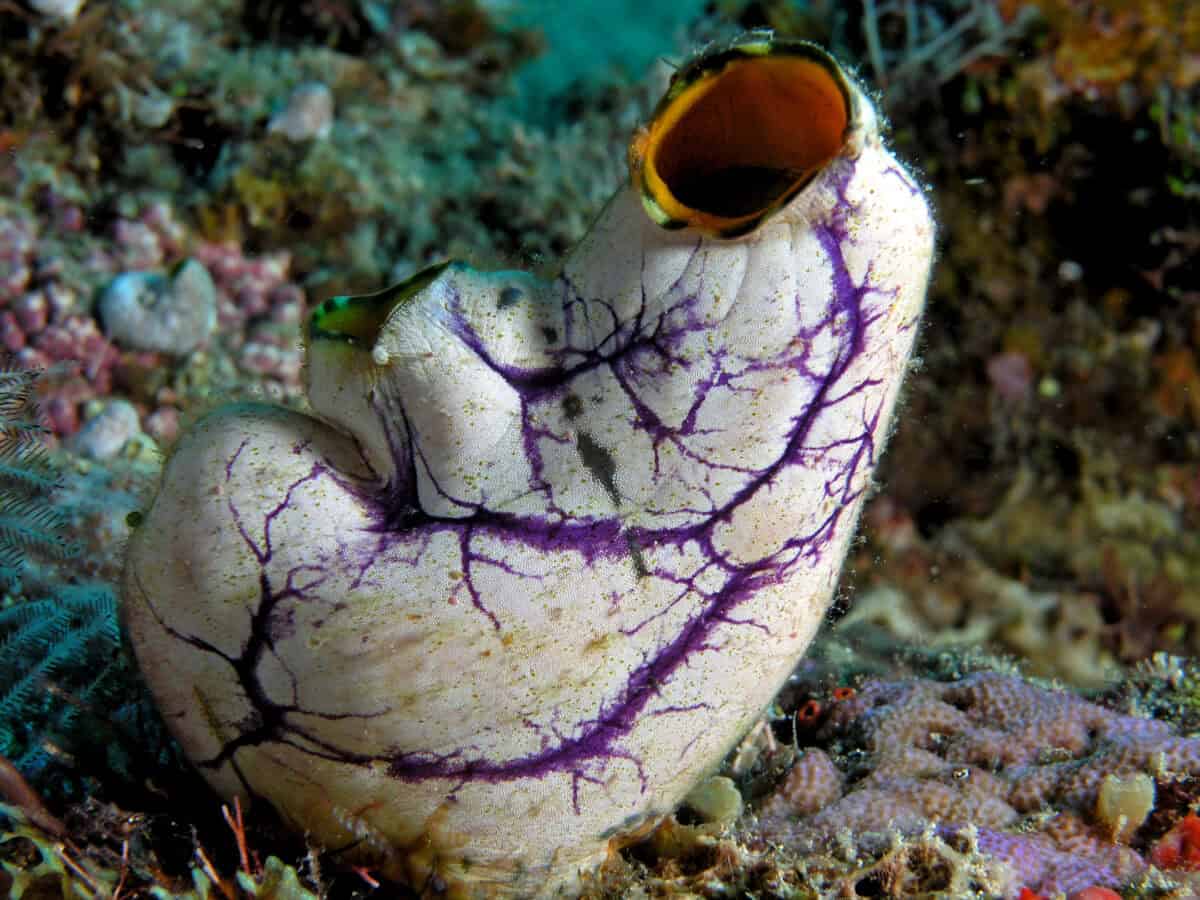
Tunicates may not look like much, but these strange, jelly-like sea creatures play an essential role in the ocean. Found from shallow waters to the deep sea, they spend their lives filtering water, removing tiny particles, and recycling nutrients back into the ecosystem.
What Makes It So Unique?
- Water filtration: Tunicates constantly filter seawater, helping to keep marine environments clean.
- Simple yet efficient: Despite looking like blobs, they have a primitive nervous system and can even regenerate lost body parts.
- Colonial lifestyle: Some tunicates form massive colonies, living together like an underwater city.
Where Does It Lurk?
- Found in all oceans, from coastal waters to the deep sea.
Why It’s Amazing
The tunicate is one of the ocean’s most important cleaners, playing a crucial role in maintaining the health of marine ecosystems. Though simple in appearance, these creatures are vital to the balance of life in the sea.
19. Deep-Sea Lizardfish – The Apex Ambusher of the Abyss
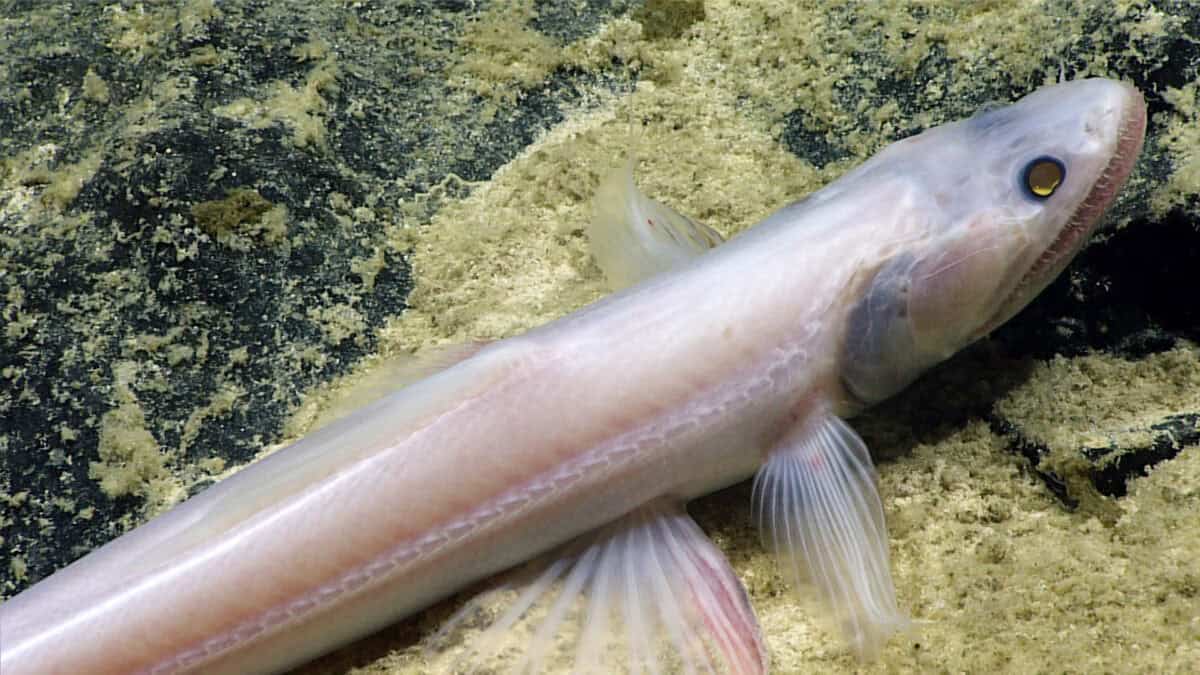
The deep-sea lizardfish is not your typical fish—it’s a nightmare lurking in the dark. With its elongated body, needle-like teeth, and a hunting strategy that relies on patience and sudden bursts of speed, this predator is one of the deep ocean’s most fearsome ambush hunters.
What Makes It So Unique?
- Long, torpedo-shaped body: Its sleek, muscular form allows it to launch itself at prey with terrifying speed.
- Transparent, dagger-like teeth: Its fangs are so long that they remain visible even when its mouth is closed, ensuring that whatever gets caught isn’t escaping.
- Bioluminescent belly: Some species have light-producing organs along their undersides, helping them blend into the faint light from above, making them nearly invisible.
Where Does It Lurk?
- Depth range: Typically found between 600 and 3,500 meters (2,000 to 11,500 feet).
- Global distribution: Found in deep-sea regions across the world, waiting motionless on the seafloor or hovering just above it.
How Does It Hunt?
- The lizardfish remains completely still, blending into the dark, waiting for an unsuspecting fish or squid to get too close.
- With a sudden, powerful burst of speed, it lunges forward and snaps its jaws shut, trapping its prey in its vice-like teeth.
- Its stomach is highly expandable, allowing it to consume meals much larger than itself, ensuring it can survive long periods without food.
Who’s Trying to Eat It?
- Very few deep-sea creatures prey on the lizardfish, but larger fish, deep-diving sharks, and giant squid may target them.
Why It’s Amazing
The deep-sea lizardfish is a true apex predator of the abyss, built for stealth, speed, and deadly precision. Its monstrous teeth and lightning-fast reflexes make it one of the most formidable hunters in the deep.
20. Barreleye Fish – The Deep Sea’s Living Periscope
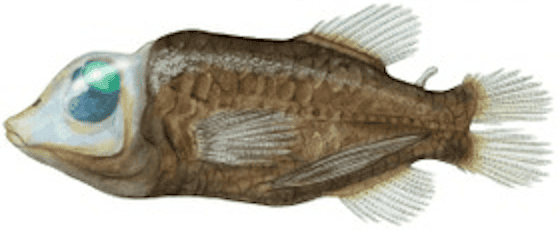
The barreleye fish might be one of the strangest creatures in the ocean. With a transparent head and upward-facing, tubular eyes, it is designed for one thing—spotting prey in the darkness above. This fish is a perfect example of deep-sea adaptation at its weirdest and most brilliant.
What Makes It So Unique?
- Transparent head: The barreleye fish has a clear, jelly-like dome over its head, allowing it to see through its own skull.
- Rotating tubular eyes: Its barrel-shaped eyes can tilt within their sockets, letting it look straight ahead or directly above without moving its body.
- Ultra-sensitive vision: Its eyes are packed with light-sensitive cells, making it one of the best-equipped fish for spotting faint silhouettes of prey in the darkness.
Where Does It Lurk?
- Depth range: Found between 600 and 800 meters (2,000 to 2,600 feet), right in the ocean’s twilight zone.
- Global distribution: Found in deep waters of the Pacific, Atlantic, and Indian Oceans, floating motionless while scanning for food.
How Does It Hunt?
- The barreleye fish stays still, keeping its eyes locked upward, watching for small fish and crustaceans silhouetted against the faint light from above.
- When it spots prey, it tilts its eyes forward and moves with precise, calculated movements to capture its meal.
- It is believed to steal food from siphonophores, jellyfish-like predators with long, dangling tentacles that catch prey—snatching meals before they are consumed.
Who’s Trying to Eat It?
- Larger predatory fish, including deep-sea dragonfish and squid, may target it, but its gelatinous body and excellent eyesight help it detect threats early.
Why It’s Amazing
The barreleye fish is a deep-sea marvel, with its transparent head and incredible vision making it one of the most advanced hunters in the twilight zone. In a world of total darkness, its ability to see through its own skull is a game-changer.
21. Rabbitfish – The Deep-Sea Oddball With a Rodent-Like Face

The rabbitfish is not named for its speed or hopping ability—it gets its name from its oddly rodent-like face. This deep-sea oddity has a long snout, a small mouth, and an eerie, ghostly appearance that makes it one of the more peculiar-looking creatures lurking in the ocean depths.
What Makes It So Unique?
- Rabbit-like face: Its long, rounded snout and small mouth resemble those of a rabbit, giving it an unusual appearance.
- Deep-sea survivalist: Its body is designed for high-pressure environments, making it perfectly suited for life in the abyss.
- Cartilaginous skeleton: Unlike most bony fish, rabbitfish have a skeleton made mostly of cartilage, making them lightweight and flexible.
Where Does It Lurk?
- Depth range: Found between 200 and 1,000 meters (650 to 3,300 feet), living in the ocean’s twilight zone.
- Global distribution: Found in deep waters worldwide, particularly in colder regions.
How Does It Hunt?
- Rabbitfish feed primarily on small invertebrates, using their elongated snouts to probe into the sand or sift through detritus on the ocean floor.
- They have small, flat teeth that help them crush their prey, which consists mostly of crustaceans and worms.
- Unlike aggressive predators, they are slow-moving and rely on camouflage and deep-sea darkness to avoid threats.
Who’s Trying to Eat It?
- Larger predatory fish and deep-sea sharks may prey on rabbitfish, though their deep habitat and cautious nature help keep them out of harm’s way.
Why It’s Amazing
The rabbitfish is an eerie, slow-moving deep-sea wanderer that stands out due to its bizarre facial structure. With its ghostly appearance and patient hunting style, it is a reminder that in the deep ocean, the strangest-looking creatures often have the best survival strategies.
22. Snailfish – The Deepest Dweller of Them All

Snailfish may not look like much at first glance, but they hold an incredible record—they are some of the deepest-living fish ever discovered.
These gelatinous, ghost-like creatures thrive in the crushing pressure of the hadal zone, where most fish would be flattened like a pancake.
With bodies built to endure conditions humans can barely imagine, snailfish are proof that life finds a way even in the most extreme environments.
What Makes It So Unique?
- Deepest-living fish: Some species of snailfish have been found at depths over 8,000 meters (26,200 feet), where pressures are more than 800 times that of the surface.
- Soft, jelly-like body: Unlike most deep-sea fish, snailfish lack swim bladders and instead rely on their gelatinous structure to maintain buoyancy.
- Highly specialized enzymes: Their cells contain unique pressure-resistant proteins, allowing them to survive in the crushing depths where other fish would be destroyed.
Where Does It Lurk?
- Depth range: Found anywhere from 200 meters to over 8,000 meters (650 to 26,200 feet), depending on the species.
- Global distribution: Found in deep-sea trenches and abyssal plains across the world’s oceans, including the Mariana Trench, the deepest place on Earth.
How Does It Hunt?
- Snailfish are opportunistic predators, feeding on small crustaceans, amphipods, and other deep-sea invertebrates.
- Their soft, flexible bodies allow them to maneuver easily along the seafloor, sucking up tiny prey with their small mouths.
- Despite their extreme habitat, they are surprisingly active and social, often found in large numbers near deep-sea thermal vents or trenches.
Who’s Trying to Eat It?
- Even in the deepest parts of the ocean, predators exist. Larger deep-sea fish, deep-diving sharks, and even scavenging invertebrates may try to make a meal of snailfish.
Why It’s Amazing
Snailfish are living proof that no part of the ocean is too extreme for life. By thriving in the planet’s deepest, most inhospitable trenches, they challenge everything we thought we knew about the limits of survival.
23. Sea Angel – The Deep-Sea’s Floating Phantom
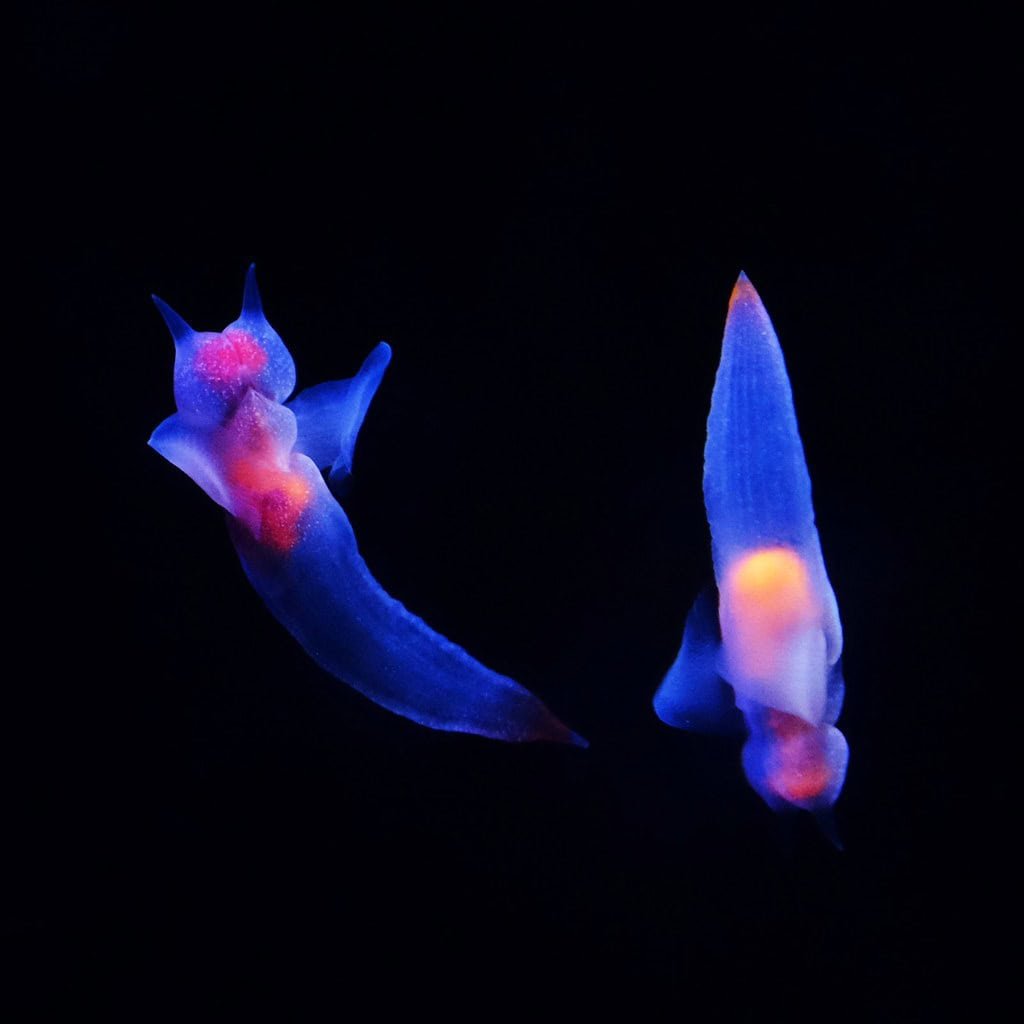
The sea angel looks more like a tiny, glowing ghost than a real animal. These transparent, winged creatures drift through the ocean like tiny spirits, flapping their “wings” as they float in search of food. But don’t be fooled by their angelic name—these creatures are actually predatory mollusks, and their hunting strategy is anything but divine.
What Makes It So Unique?
- Wing-like flaps: Unlike typical snails, sea angels have evolved away from shells, using two wing-like appendages to propel themselves gracefully through the water.
- Transparent body: Their bodies are almost entirely see-through, making them nearly invisible in the open ocean.
- Secret predator: Despite their angelic appearance, sea angels are ruthless hunters, feeding on their relatives—tiny swimming snails called sea butterflies.
Where Does It Lurk?
- Depth range: Found from the surface down to about 1,500 meters (4,900 feet).
- Global distribution: Found in polar, deep-sea, and open-ocean environments, with different species living in the Arctic, Antarctic, and deep tropical waters.
How Does It Hunt?
- Sea angels use specialized tentacle-like structures to grab onto sea butterflies, pulling them in before devouring them alive.
- They have a hidden set of “teeth” that they use to scrape away their prey’s soft body.
- Some species produce a nasty chemical deterrent to ward off predators, making them both graceful and deadly.
Who’s Trying to Eat It?
- Larger fish and jellyfish often feed on sea angels, though their chemical defenses make them unappealing to many predators.
Why It’s Amazing
The sea angel is one of the ocean’s most otherworldly creatures, looking like something out of a fantasy novel. Despite their tiny size and delicate appearance, they are perfectly adapted to their environment, proving that even in the deep sea, beauty and brutality go hand in hand.
24. Lanternfish – The Deep Ocean’s Living Light Show
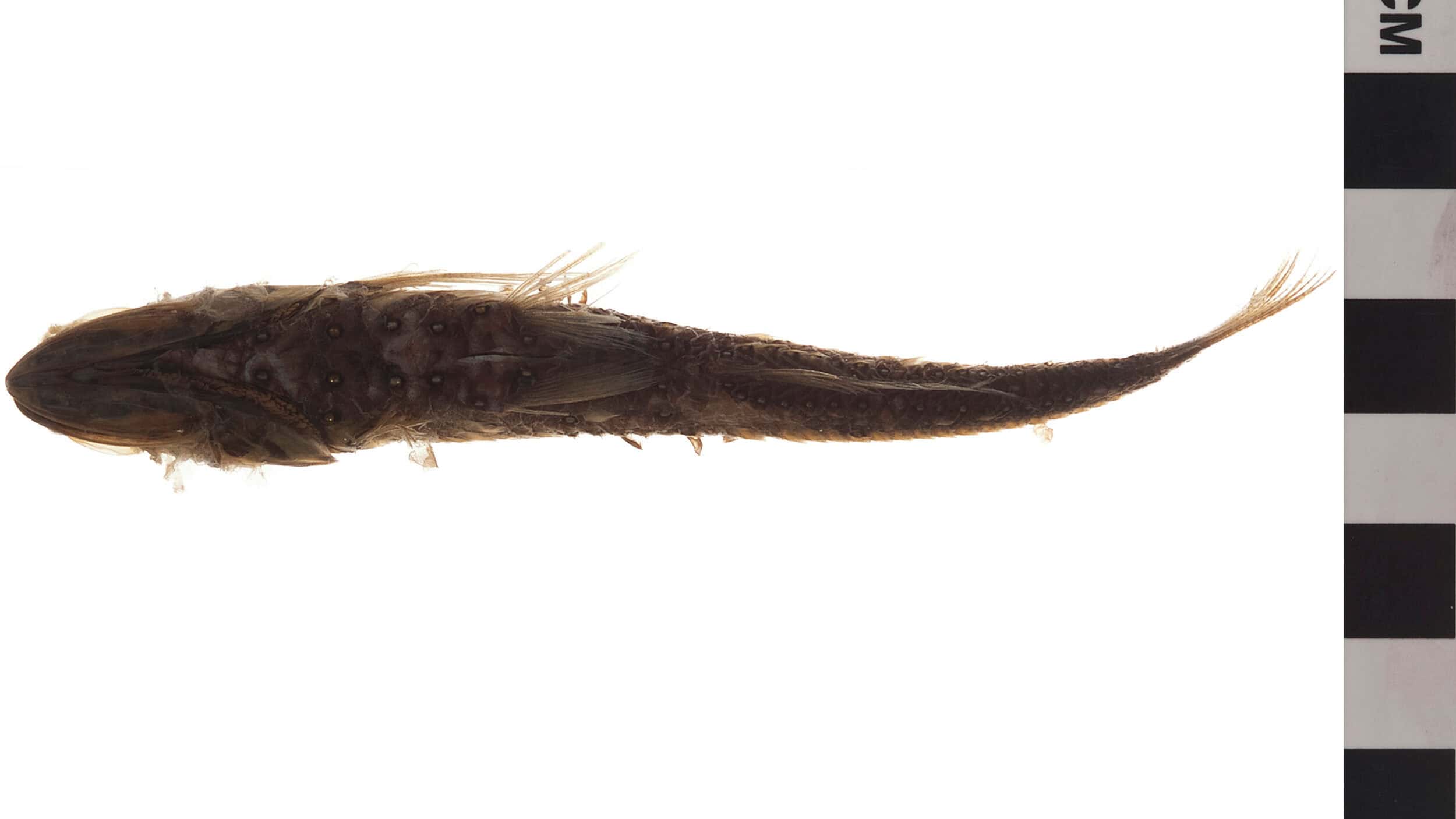
Lanternfish are one of the most abundant fish in the deep sea, and yet, most people have never heard of them. These tiny, glowing fish make up a huge portion of the ocean’s biomass and are a vital food source for countless deep-sea predators. With their flashing bioluminescent patterns, lanternfish are like tiny, floating lanterns in the dark, endlessly migrating up and down the ocean depths.
What Makes It So Unique?
- Bioluminescent camouflage: Lanternfish have rows of light-producing organs along their bodies, which help them blend into the faint light from above, making them nearly invisible to predators.
- Massive daily migrations: These fish travel hundreds of meters up and down the water column every day, feeding in shallower waters at night and retreating to the deep by day.
- Critical part of the food chain: Despite their small size, lanternfish play a crucial role in ocean ecosystems, serving as food for everything from deep-sea fish and squid to massive whales.
Where Does It Lurk?
- Depth range: Found from 200 to 1,500 meters (650 to 4,900 feet), though they migrate closer to the surface at night.
- Global distribution: Found in every ocean on Earth, making them one of the most widespread fish species.
How Does It Hunt?
- Lanternfish are omnivorous, feeding mostly on plankton, tiny crustaceans, and small jellyfish.
- They rely on their bioluminescent camouflage to avoid predators while foraging.
- Some species flash light signals to communicate with others, possibly for mating or schooling behavior.
Who’s Trying to Eat It?
- Almost everything in the deep sea eats lanternfish, including squid, larger fish, deep-diving sharks, and whales.
- They make up a significant portion of the diet of deep-diving predators like sperm whales and giant squid.
Why It’s Amazing
Lanternfish may be tiny, but they are one of the most important creatures in the deep ocean. Their massive populations and daily migrations help cycle nutrients throughout the ocean while supporting countless marine species.
Without them, much of the deep sea’s food web would collapse. In a world of monstrous predators and strange glowing creatures, the humble lanternfish might just be the real king of the abyss.
25. Black Swallower – The Deep Sea’s Ultimate Overeater
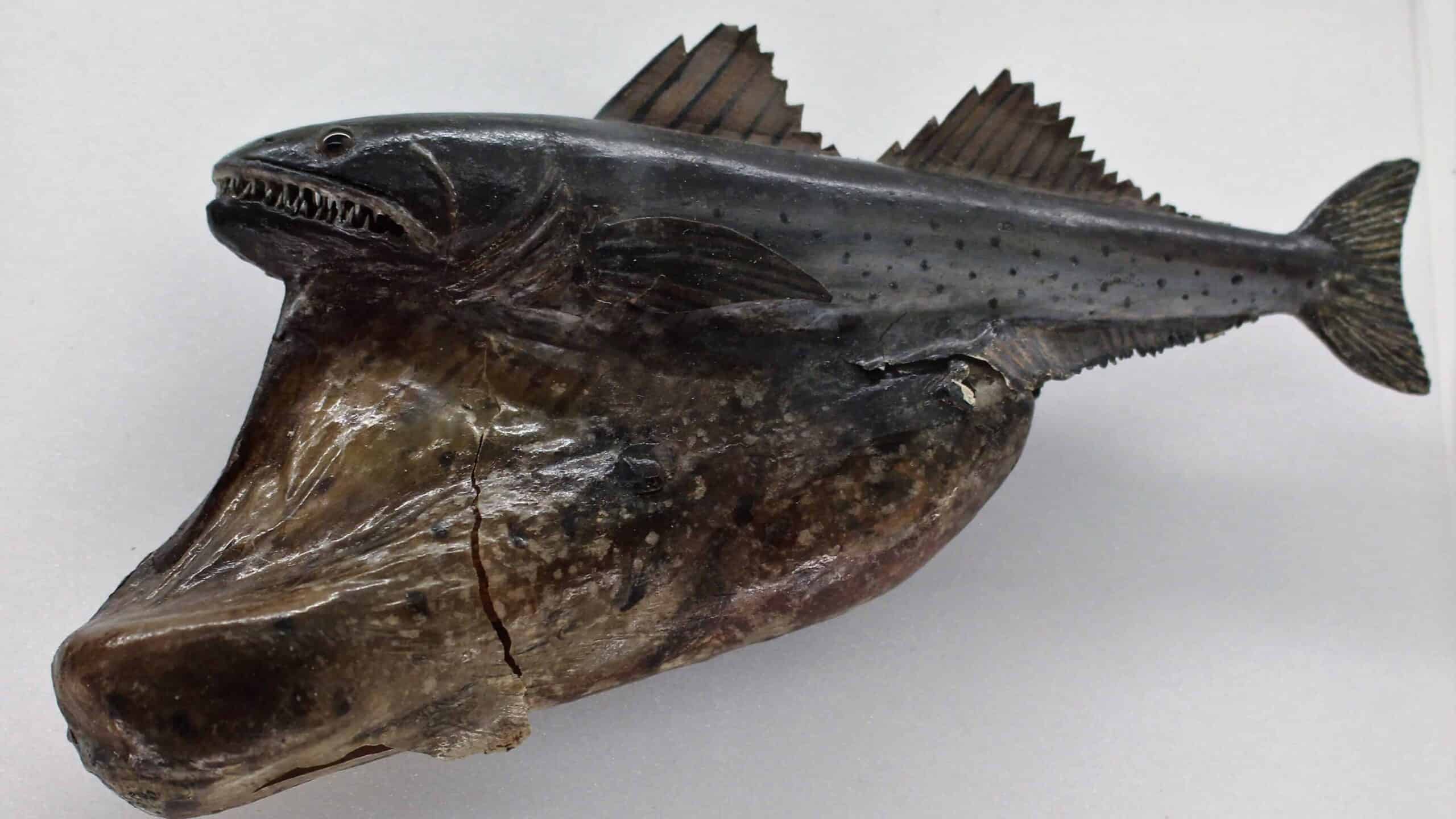
The black swallower might just be one of the most ambitious eaters in the ocean. This small, unassuming deep-sea fish has one of the most extreme survival strategies—swallowing prey that is much larger than itself.
It’s not just a little overeating; the black swallower can stretch its stomach to ridiculous proportions, sometimes biting off more than it can handle, literally.
What Makes It So Unique?
- Extreme stomach expansion: The black swallower can gulp down fish up to ten times its own size and twice its length thanks to its ultra-stretchy stomach.
- Slow-motion digestion: Because it swallows meals so large, it takes an incredibly long time to digest food, making each meal a serious long-term investment.
- Sometimes too ambitious: If the prey is too large, the swallower can end up rotting from the inside out before it finishes digestion—an unfortunate price for overeating.
Where Does It Lurk?
- Depth range: Found between 700 and 2,700 meters (2,300 to 8,900 feet), where food is scarce, making its extreme eating habits a necessary survival tactic.
- Global distribution: Lives in tropical and subtropical deep-sea waters around the world, waiting for the right meal to float by.
How Does It Hunt?
- The black swallower uses its sharp, backward-facing teeth to grab onto passing prey, making escape nearly impossible.
- Once it has a solid grip, it slowly works its jaws over the entire fish, swallowing it whole, headfirst.
- Its elastic stomach stretches to accommodate its oversized meal, allowing it to digest the fish slowly over time.
Who’s Trying to Eat It?
- Since it spends most of its time in deep water, the black swallower has few predators, but larger deep-sea fish and squid may go after it.
- Its biggest enemy might just be its own appetite—sometimes, it swallows prey too large to digest, leading to its own demise.
Why It’s Amazing
The black swallower is the ultimate go-big-or-go-home eater of the deep sea. With a stomach that defies all logic and a feeding strategy that pushes the limits of survival, this deep-sea predator proves that sometimes, biting off more than you can chew is a way of life.
Final Thoughts
From fish that glow in the dark to creatures that swallow prey much larger than themselves, the deep ocean is filled with life-forms that push the boundaries of what we thought possible. Each of these 25 bizarre creatures has adapted to a harsh world of crushing pressure and near-total darkness, demonstrating that survival in the abyss requires a combination of innovation and resilience. By learning about these mysterious residents of the deep, we gain a greater appreciation for the hidden wonders of our planet and the immense biodiversity that thrives where few humans have ever ventured.
- 13 Rare Cat Breeds You Didn’t Know Existed - July 29, 2025
- 20 Fun and Unbelievable Animal Facts That Will Make Your Day - July 28, 2025
- 11 Animals That Are Fighting Climate Change - July 28, 2025

